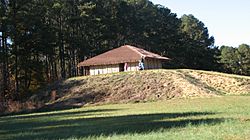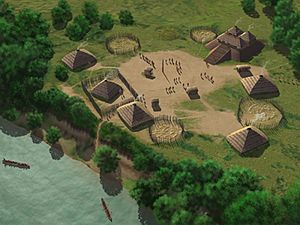Pedee people facts for kids

Town Creek Mound, a precontact Pee Dee culture site in North Carolina
|
|
| Regions with significant populations | |
|---|---|
| United States (South Carolina) | |
| Languages | |
| unknown, likely Siouan language | |
| Related ethnic groups | |
| Catawba |
The Pee Dee people (also called Pedee or Peedee) are a group of Native Americans from the southeastern United States. For a long time, most of them lived in the Piedmont area of what is now South Carolina. In the 1600s and 1700s, English settlers named the Pee Dee River and the Pee Dee region of South Carolina after this tribe. Today, several groups say they are descendants of the Pedee people. Some of these groups are officially recognized by the state.
Contents
What Does the Name "Pee Dee" Mean?
The meaning of the name Pedee is not known today.
Ancient History of the Pee Dee People

The Pee Dee culture refers to a period of history from about 1000 to 1500 CE. This time is split into three parts: the Teal phase (1000–1200), Town Creek phase (1200–1400), and Leak phase (1400–1500).
The Pee Dee people were part of the South Appalachian Mississippian culture. This culture started around 980 CE and spread into what is now North Carolina and Tennessee. The Pee Dee were involved in a large trade network. This network reached from Georgia to South Carolina, eastern Tennessee, and the mountain and Piedmont areas of North Carolina.
The Pee Dee culture became its own distinct group by 980 CE. They thrived in the Pee Dee River area of North and South Carolina before Christopher Columbus arrived. For example, the Town Creek Indian Mound site in western North Carolina was used from about 1150 to 1400 CE.
Town Creek Indian Mound in Montgomery County, North Carolina is an important Pee Dee culture site from this early period. For 50 years, starting in 1937, archaeologists studied the Town Creek Indian Mound and village. Their research helped us learn a lot about the Pee Dee culture. This mound and village site is now a National Historic Landmark.
Later History of the Pee Dee People
Around 1550, the Pedee people moved from the lower Pee Dee River to the upper Pee Dee River in the Piedmont area. They stayed there for about 100 years. They took the place of local tribes like the Saponi, who later returned when the Pedee left.
Historian Charles M. Hudson thinks this move might have been to avoid Spanish groups who were capturing people along South Carolina's coast. In the 1500s, these Pedee people, like their neighbors the Waxhaw, shaped their babies' heads. In 1567, Spanish explorers found a village called Vehidi on the Pee Dee River. They believed it was a Pedee settlement.
In 1600, there were an estimated 600 Pedee people. Many Europeans, mostly from the British Isles, began settling in South Carolina in the 1600s and early 1700s. The English set up a trading post in 1716 to trade with the Pedee and Waccamaw tribes. The Winyaw and Cape Fear Indians also moved up the Pee Dee River to this trading post.
The Tuscarora War
In 1711, the Tuscarora War started in North Carolina. Tribes from South Carolina joined the fighting. In 1712, Pedee warriors, along with the Saraw, Saxapahaw, Winyaw, and Cape Fear Indians, fought with the British against the Tuscarora. They helped defeat them. After this, most of the Tuscarora moved north to join the Haudenosaunee Confederacy of Iroquois tribes in New York and Ontario.
In 1715, English mapmakers showed a Pedee village on the west side of the Pee Dee River.
The Yamasee War
The friendships between the Pedee and other tribes during this time continued into the Yamasee War (1715–1717). This war caused big changes for the Southeastern tribes. Some historians wrote that many tribes, including the Pedee, were "utterly wiped out." However, some survivors likely found safety with the Catawba tribe, who lived near the South and North Carolina border.
In 1737, the Pedee tribe asked South Carolina for a piece of land to live on. In 1738, they and their Natchez relatives were given a 100-acre (0.40 km2) plot of land by James Coachman. This land was in Berkeley County, along the Edisto River.
In the 1740s, English settlers in South Carolina called the Pedee, along with the Sara, Yuchi, Natchez, and Cape Fear Indians, "settlement Indians." In 1744, the Natchez and Pedee attacked some Catawba people. Because of this, the Catawba pushed them into European settlements. In 1746, the Pedee and Sara were mentioned as two small tribes that had joined the Catawba. However, they were not happy with this arrangement. Like other tribes during this time, some Pedee people had African-American people working for them, often against their will.
In 1751, at a meeting of different tribes in Albany, New York, the Pedee were noted as a small tribe living among European colonists. In 1752, Catawba leaders asked the Pedee to settle with their tribe. On May 29, 1755, Governor John Glen told Catawba leader King Haigler that South Carolina had "persuaded the Charraws, Waccamaws, and some of the Pedees to join you [the Catawba]." When the Cherokee killed Pedee and Waccamaw people in 1755, they were still living in European settlements. This mention in 1755 was one of the last historical records of the Pedee people until the 1900s.
A historian wrote that in 1808, older neighbors remembered when about 30 Pedee and Cape Fear Indians lived in their old lands. But by 1808, the Pedee and Cape Fear tribes were represented by only one woman who was of mixed heritage.
Language of the Pee Dee People
The Pedee language was no longer spoken by the 1800s. No words from the language were ever written down. However, language experts believe it was part of the Catawban languages, which is a branch of the Siouan language family. Pedee might have been a different way of speaking the Catawba language, which is also no longer spoken.
Modern Pee Dee Groups
The State of South Carolina has officially recognized two Pee Dee tribes and one Pee Dee group.
The state-recognized tribes are:
- Pee Dee Indian Nation of Upper South Carolina, Little Rock, South Carolina (recognized in 2005). In 2008, they had 532 members, mostly living in Dillon and Marlboro counties.
- Pee Dee Indian Tribe of South Carolina, McColl, South Carolina (recognized in 2006).
The one state-recognized group is:
- Pee Dee Indian Tribe of Beaver Creek, Neeses, South Carolina (recognized in 2007).

